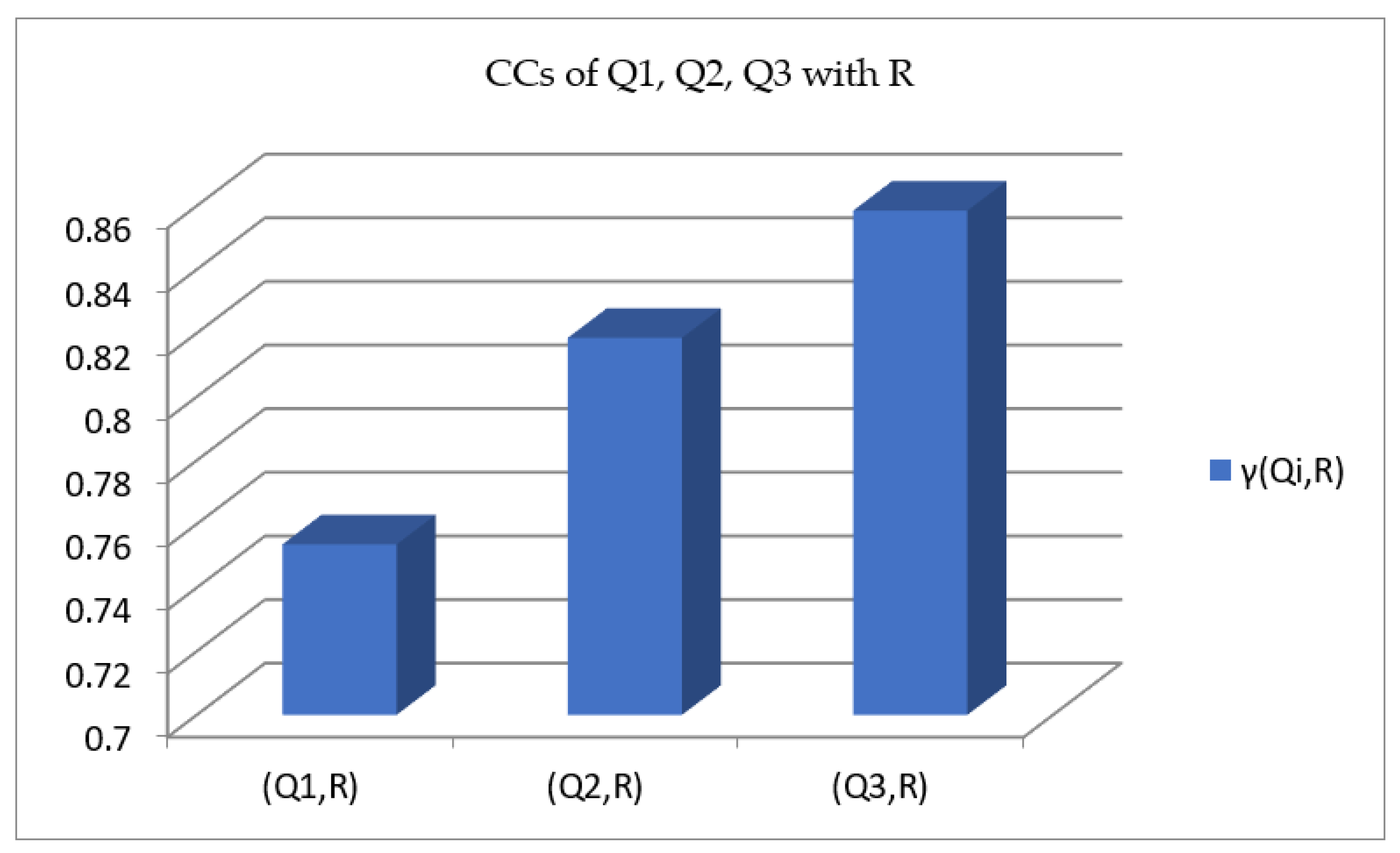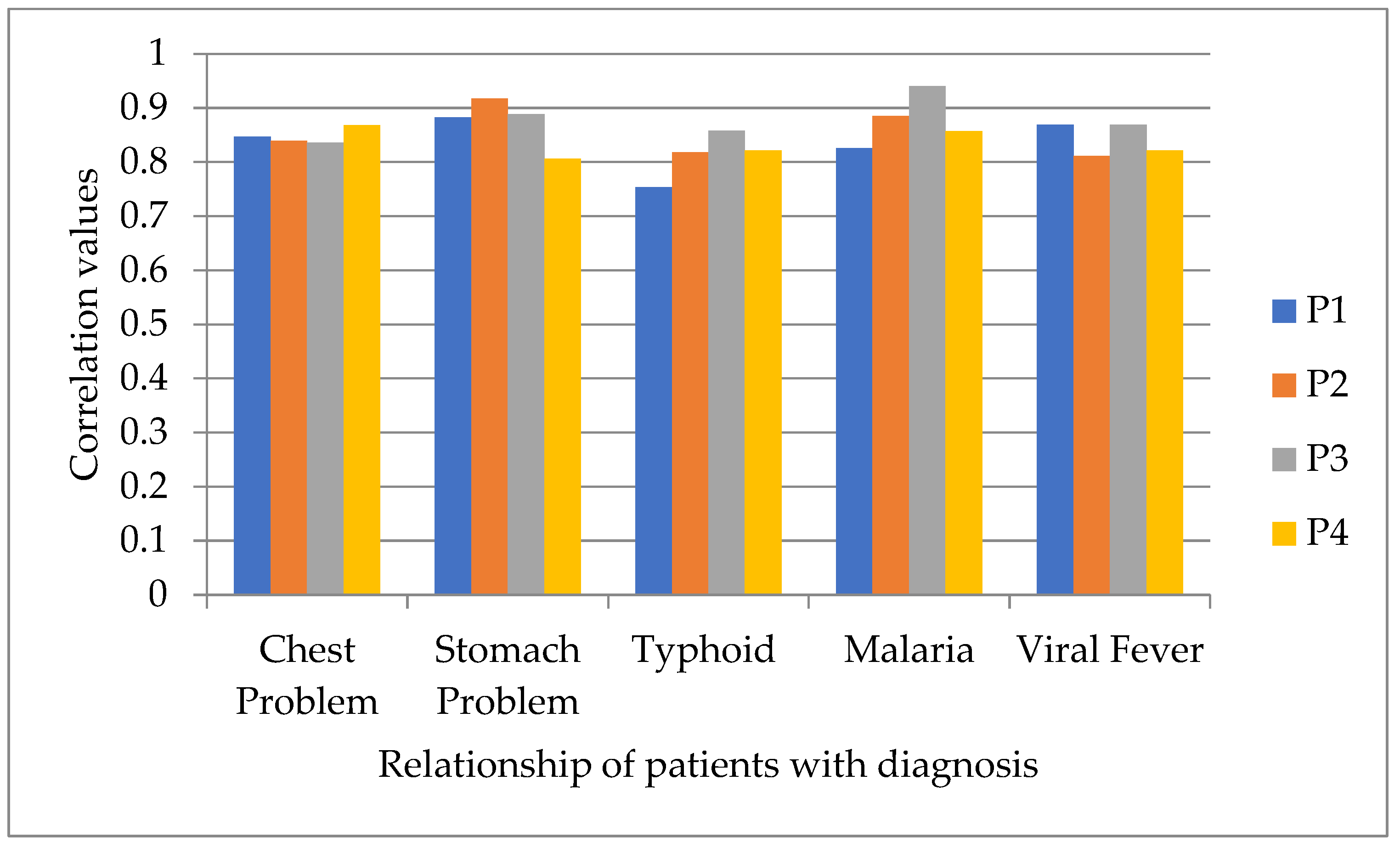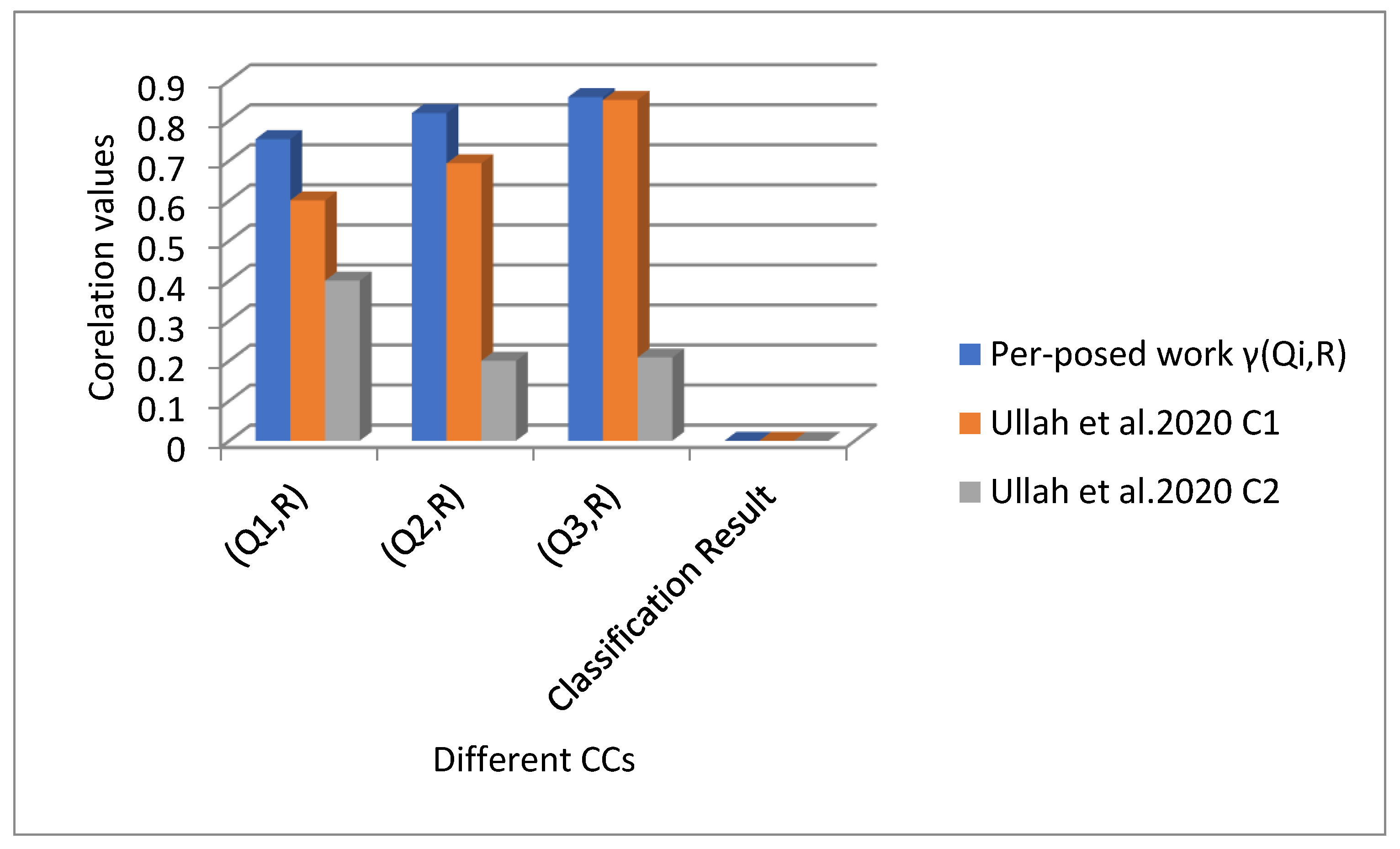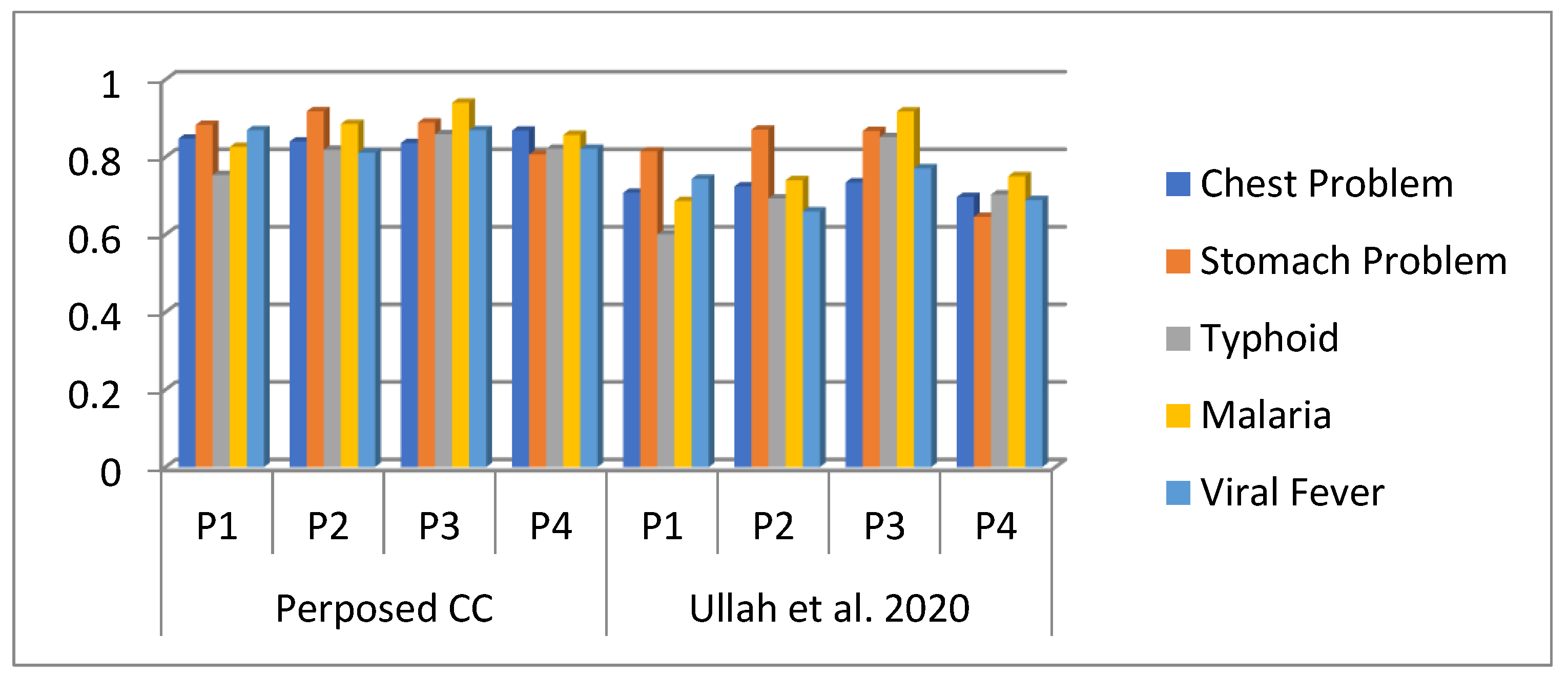A New Correlation Coefficient Based on T-Spherical Fuzzy Information with Its Applications in Medical Diagnosis and Pattern Recognition
Abstract
1. Introduction
2. Preliminaries
3. A New Correlation Coefficient for TSFSs
- (1)
- .
- (2)
- (3)
- ifand.
- (4)
- IfThen,.
- (1)
- The first is true self.
- (2)
- Second proofs is true self.
- (3)
- Take to prove the third part, i.e., , , , hence Equation implies
- (1)
- If we replace then we obtain CC for SFSs.
- (2)
- If we replace then we obtain CC for PFS.
- (3)
- If we neglect AD, then we obtain CC for q-ROFSs.
- (4)
- If we replace and neglect AD, then we obtain CC for PyFSs.
- (5)
- If we replace and neglect AD, then we obtain CC for IFSs.
- (1)
- .
- (2)
- (3)
- ifand
4. Application of the Presented T-Spherical Fuzzy Correlation Coefficient (TSFCC)
4.1. Application of the Presented Correlation Coefficient of TSFSs in Pattern Recognition for Investment Decision
4.2. Application in Medical Diagnosis
5. Conclusions
- Our suggested TSFCC is based on the TSFS. Hence, the proposed CC accommodates the information in the more generalized form than the CC defined for IFS, PyFS, qROPFS, and PFS. It is more useful CC due to the characteristic of TSFS of obtaining maximum information from the real-life scenario.
- The proposed CC aggregates a larger range of information than the PFS. Consequently, the proposed CC can be applied more effectively to real-life problems of pattern recognition, medical diagnosis and feature selection.
Author Contributions
Funding
Institutional Review Board Statement
Informed Consent Statement
Data Availability Statement
Acknowledgments
Conflicts of Interest
References
- Zadeh, L.A. Fuzzy Sets. Inf. Control 1965, 8, 338–353. [Google Scholar] [CrossRef]
- Atanassov, K. Intuitionistic Fuzzy Sets. Fuzzy Sets Syst. 1986, 20, 87–96. [Google Scholar] [CrossRef]
- Yager, R.R. Pythagorean Fuzzy Subsets. In Proceedings of the 2013 Joint IFSA World Congress and NAFIPS Annual Meeting (IFSA/NAFIPS), Edmonton, AB, Canada, 24–28 June 2013; pp. 57–61. [Google Scholar]
- Yager, R.R. Generalized Orthopair Fuzzy Sets. IEEE Trans. Fuzzy Syst. 2016, 25, 1222–1230. [Google Scholar] [CrossRef]
- Cuong, B.C. Picture Fuzzy Sets. JCC 2015, 30, 409–420. [Google Scholar] [CrossRef]
- Mahmood, T.; Ullah, K.; Khan, Q.; Jan, N. An Approach toward Decision-Making and Medical Diagnosis Problems Using the Concept of Spherical Fuzzy Sets. Neural Comput. Appl. 2019, 31, 7041–7053. [Google Scholar] [CrossRef]
- Wang, C.-N.; Nguyen, N.-A.-T.; Dang, T.-T. Offshore Wind Power Station (OWPS) Site Selection Using a Two-Stage MCDM-Based Spherical Fuzzy Set Approach. Sci. Rep. 2022, 12, 4260. [Google Scholar] [CrossRef]
- Hussain, A.; Ullah, K.; Yang, M.-S.; Pamucar, D. Aczel-Alsina Aggregation Operators on T-Spherical Fuzzy (TSF) Information with Application to TSF Multi-Attribute Decision Making. IEEE Access 2022, 10, 26011–26023. [Google Scholar] [CrossRef]
- Hussain, A.; Ullah, K.; Wang, H.; Bari, M. Assessment of the Business Proposals Using Frank Aggregation Operators Based on Interval-Valued T-Spherical Fuzzy Information. J. Funct. Spaces 2022, 2022, e2880340. [Google Scholar] [CrossRef]
- Akram, M.; Ullah, K.; Pamucar, D. Performance Evaluation of Solar Energy Cells Using the Interval-Valued T-Spherical Fuzzy Bonferroni Mean Operators. Energies 2022, 15, 292. [Google Scholar] [CrossRef]
- Chen, Y.; Munir, M.; Mahmood, T.; Hussain, A.; Zeng, S. Some Generalized T-Spherical and Group-Generalized Fuzzy Geometric Aggregation Operators with Application in MADM Problems. J. Math. 2021, 2021, 5578797. [Google Scholar] [CrossRef]
- Garg, H.; Munir, M.; Ullah, K.; Mahmood, T.; Jan, N. Algorithm for T-Spherical Fuzzy Multi-Attribute Decision Making Based on Improved Interactive Aggregation Operators. Symmetry 2018, 10, 670. [Google Scholar] [CrossRef]
- Hwang, C.-M.; Yang, M.-S.; Hung, W.-L.; Lee, M.-G. A Similarity Measure of Intuitionistic Fuzzy Sets Based on the Sugeno Integral with Its Application to Pattern Recognition. Inf. Sci. 2012, 189, 93–109. [Google Scholar] [CrossRef]
- Zeng, S.; Zhou, J.; Zhang, C.; Merigó, J.M. Intuitionistic Fuzzy Social Network Hybrid MCDM Model for an Assessment of Digital Reforms of Manufacturing Industry in China. Technol. Forecast. Soc. Chang. 2022, 176, 121435. [Google Scholar] [CrossRef]
- Boran, F.E.; Akay, D. A Biparametric Similarity Measure on Intuitionistic Fuzzy Sets with Applications to Pattern Recognition. Inf. Sci. 2014, 255, 45–57. [Google Scholar] [CrossRef]
- Firozja, M.A.; Agheli, B.; Jamkhaneh, E.B. A New Similarity Measure for Pythagorean Fuzzy Sets. Complex Intell. Syst. 2020, 6, 67–74. [Google Scholar] [CrossRef]
- Zeng, S.; Zhang, N.; Zhang, C.; Su, W.; Carlos, L.-A. Social Network Multiple-Criteria Decision-Making Approach for Evaluating Unmanned Ground Delivery Vehicles under the Pythagorean Fuzzy Environment. Technol. Forecast. Soc. Change 2022, 175, 121414. [Google Scholar] [CrossRef]
- Zhang, Q.; Hu, J.; Feng, J.; Liu, A.; Li, Y. New Similarity Measures of Pythagorean Fuzzy Sets and Their Applications. IEEE Access 2019, 7, 138192–138202. [Google Scholar] [CrossRef]
- Farhadinia, B.; Effati, S.; Chiclana, F. A Family of Similarity Measures for Q-Rung Orthopair Fuzzy Sets and Their Applications to Multiple Criteria Decision Making. Int. J. Intell. Syst. 2021, 36, 1535–1559. [Google Scholar] [CrossRef]
- Garg, H.; Ali, Z.; Mahmood, T. Generalized Dice Similarity Measures for Complex Q-Rung Orthopair Fuzzy Sets and Its Application. Complex Intell. Syst. 2021, 7, 667–686. [Google Scholar] [CrossRef]
- Luo, M.; Zhang, Y. A New Similarity Measure between Picture Fuzzy Sets and Its Application. Eng. Appl. Artif. Intell. 2020, 96, 103956. [Google Scholar] [CrossRef]
- Zhao, R.; Luo, M.; Li, S. A Dynamic Distance Measure of Picture Fuzzy Sets and Its Application. Symmetry 2021, 13, 436. [Google Scholar] [CrossRef]
- Verma, R.; Rohtagi, B. Novel Similarity Measures between Picture Fuzzy Sets and Their Applications to Pattern Recognition and Medical Diagnosis. Granul. Comput. 2022, 7, 761–777. [Google Scholar] [CrossRef]
- On a New Picture Fuzzy Correlation Coefficient with Its Applications to Pattern Recognition and Identification of an Investment Sector|SpringerLink. Available online: https://link.springer.com/article/10.1007/s40314-021-01699-w (accessed on 30 September 2022).
- Mitchell, H.B. A Correlation Coefficient for Intuitionistic Fuzzy Sets. Int. J. Intell. Syst. 2004, 19, 483–490. [Google Scholar] [CrossRef]
- Xuan Thao, N. A New Correlation Coefficient of the Intuitionistic Fuzzy Sets and Its Application. J. Intell. Fuzzy Syst. 2018, 35, 1959–1968. [Google Scholar] [CrossRef]
- Thao, N.X. A New Correlation Coefficient of the Pythagorean Fuzzy Sets and Its Applications. Soft Comput. 2020, 24, 9467–9478. [Google Scholar] [CrossRef]
- Garg, H.; Rani, D. A Robust Correlation Coefficient Measure of Complex Intuitionistic Fuzzy Sets and Their Applications in Decision-Making. Appl. Intell. 2019, 49, 496–512. [Google Scholar] [CrossRef]
- Garg, H. A Novel Correlation Coefficients between Pythagorean Fuzzy Sets and Its Applications to Decision-Making Processes. Int. J. Intell. Syst. 2016, 31, 1234–1252. [Google Scholar] [CrossRef]
- Riaz, M.; Habib, A.; Khan, M.J.; Kumam, P. Correlation Coefficients for Cubic Bipolar Fuzzy Sets with Applications to Pattern Recognition and Clustering Analysis. IEEE Access 2021, 9, 109053–109066. [Google Scholar] [CrossRef]
- Mahmood, T.; Ali, Z. Entropy Measure and TOPSIS Method Based on Correlation Coefficient Using Complex Q-Rung Orthopair Fuzzy Information and Its Application to Multi-Attribute Decision Making. Soft Comput. 2021, 25, 1249–1275. [Google Scholar] [CrossRef]
- Joshi, R.; Kumar, S. A Novel VIKOR Approach Based on Weighted Correlation Coefficients and Picture Fuzzy Information for Multicriteria Decision Making. Granul. Comput. 2022, 7, 323–336. [Google Scholar] [CrossRef]
- Singh, P. Correlation Coefficients for Picture Fuzzy Sets. J. Intell. Fuzzy Syst. 2015, 28, 591–604. [Google Scholar] [CrossRef]
- Ullah, K.; Garg, H.; Mahmood, T.; Jan, N.; Ali, Z. Correlation Coefficients for T-Spherical Fuzzy Sets and Their Applications in Clustering and Multi-Attribute Decision Making. Soft Comput. 2020, 24, 1647–1659. [Google Scholar] [CrossRef]
- Full Article: Complex Interval-Valued q-Rung Orthopair 2-Tuple Linguistic Aggregation Operators and Their Application in Multi-Attribute Decision-Making. Available online: https://www.tandfonline.com/doi/full/10.1080/08839514.2022.2033471 (accessed on 30 August 2022).
- Yang, S.; Pan, Y.; Zeng, S. Decision Making Framework Based Fermatean Fuzzy Integrated Weighted Distance and TOPSIS for Green Low-Carbon Port Evaluation. Eng. Appl. Artif. Intell. 2022, 114, 105048. [Google Scholar] [CrossRef]
- Mahmood, T. A Novel Approach towards Bipolar Soft Sets and Their Applications. J. Math. 2020, 2020, 4680808. [Google Scholar] [CrossRef]
- Barbosa de Paula, N.O.; de Araújo Costa, I.P.; Drumond, P.; Lellis Moreira, M.Â.; Simões Gomes, C.F.; dos Santos, M.; do Nascimento Maêda, S.M. Strategic Support for the Distribution of Vaccines against Covid-19 to Brazilian Remote Areas: A Multicriteria Approach in the Light of the ELECTRE-MOr Method. Procedia Comput. Sci. 2022, 199, 40–47. [Google Scholar] [CrossRef] [PubMed]
- Lellis Moreira, M.Â.; Simões Gomes, C.F.; dos Santos, M.; da Silva Júnior, A.C.; de Araújo Costa, I.P. Sensitivity Analysis by the PROMETHEE-GAIA Method: Algorithms Evaluation for COVID-19 Prediction. Procedia Comput. Sci. 2022, 199, 431–438. [Google Scholar] [CrossRef] [PubMed]
- Yang, J.-Q.; Chen, C.-H.; Li, J.-Y.; Liu, D.; Li, T.; Zhan, Z.-H. Compressed-Encoding Particle Swarm Optimization with Fuzzy Learning for Large-Scale Feature Selection. Symmetry 2022, 14, 1142. [Google Scholar] [CrossRef]
- Tang, Y.; Pan, Z.; Pedrycz, W.; Ren, F.; Song, X. Based Kernel Fuzzy Clustering with Weight Information Granules. IEEE Trans. Emerg. Top. Comput. Intell. 2022, 1–15. [Google Scholar] [CrossRef]
- Stakeholder-Inclusive Multi-Criteria Development of Smart Cities—ScienceDirect. Available online: https://www.sciencedirect.com/science/article/abs/pii/S0148296322007287 (accessed on 4 October 2022).


| Classification Result | ||||
|---|---|---|---|---|
| 0.7536 | 0.8185 | 0.8585 |
| CRC | Classification Result | |||
|---|---|---|---|---|
| Present work | ||||
| Ullah et al. [34] | ||||
| Ullah et al. [34] |
| Chest Pain | Cough | Stomach Pain | Headache | Temperature | |
|---|---|---|---|---|---|
| Chest problem | (0.55, 0.66, 0.55) | (0.22, 0.55, 0.65) | (0.33, 0.65, 0.78) | (0.48, 0.56, 0.72) | (0.36, 0.26, 0.77) |
| Stomach problem | (0.65, 0.58, 0.77) | (0.38, 0.49, 0.56) | (0.71, 0.69, 0.50) | (0.44, 0.56, 0.35) | (0.65, 0.71, 0.56) |
| Typhoid | (0.75, 0.58, 0.66) | (0.29, 0.36, 0.45) | (0.57, 0.35, 0.66) | (0.22, 0.48, 0.68) | (0.44, 0.85, 0.33) |
| Malaria | (0.58, 0.52, 0.66) | (0.71, 0.55, 0.44) | (0.44, 0.56, 0.35) | (0.36, 0.56, 0.80) | (0.39, 0.68, 0.33) |
| Viral fever | (0.59, 0.66, 0.72) | (0.78, 0.45, 0.36) | (0.22, 0.68, 0.55) | (0.56, 0.42, 0.38) | 0.36, 0.48, 0.62) |
| Chest Pain | Cough | Stomach Pain | Headache | Temperature | |
|---|---|---|---|---|---|
| (0.35, 0.56, 0.77) | (0.66, 0.78, 0.34) | (0.57, 0.69, 0.78) | (0.35, 0.67, 0.43) | (0.73, 0.44, 0.66) | |
| (0.33, 0.52, 0.68) | (0.50, 0.78, 0.55) | (0.75, 0.56, 0.44) | (0.22, 0.65, 0.55) | (0.44, 0.55, 0.66) | |
| (0.44, 0.32, 0.58) | (0.56, 0.33, 0.58) | (0.53, 0.56, 0.45) | (0.39, 0.55, 0.66) | (0.11, 0.64, 0.54) | |
| (0.53, 0.64, 0.22) | (0.66, 0.43, 0.45) | (0.33, 0.65, 0.75) | (0.36, 0.55, 0.68) | (0.80, 0.55, 0.33) |
| Chest Problem | Stomach Problem | Typhoid | Malaria | Viral Fever | |
|---|---|---|---|---|---|
| 0.8473 | 0.8828 | 0.7536 | 0.8260 | 0.8690 | |
| 0.8398 | 0.9178 | 0.8185 | 0.8855 | 0.8111 | |
| 0.8358 | 0.8890 | 0.8585 | 0.9401 | 0.8689 | |
| 0.8681 | 0.8064 | 0.8213 | 0.8570 | 0.8212 |
| CC | Ranking Order | Diagnosed Disease |
|---|---|---|
| Current work | has Stomach problem | |
| has Stomach problem | ||
| has Malaria | ||
| has Chest problem | ||
| Ullah et al. [34] | has Stomach problem | |
| has Stomach problem | ||
| has Malaria | ||
| has Chest problem | ||
| Mitchell [25] | Not applicable | Not applicable |
| Thao [27] | Not applicable | Not applicable |
| Garg and Rani [28] | Not applicable | Not applicable |
| Garg [29] | Not applicable | Not applicable |
Publisher’s Note: MDPI stays neutral with regard to jurisdictional claims in published maps and institutional affiliations. |
© 2022 by the authors. Licensee MDPI, Basel, Switzerland. This article is an open access article distributed under the terms and conditions of the Creative Commons Attribution (CC BY) license (https://creativecommons.org/licenses/by/4.0/).
Share and Cite
Jin, Y.; Hussain, M.; Ullah, K.; Hussain, A. A New Correlation Coefficient Based on T-Spherical Fuzzy Information with Its Applications in Medical Diagnosis and Pattern Recognition. Symmetry 2022, 14, 2317. https://doi.org/10.3390/sym14112317
Jin Y, Hussain M, Ullah K, Hussain A. A New Correlation Coefficient Based on T-Spherical Fuzzy Information with Its Applications in Medical Diagnosis and Pattern Recognition. Symmetry. 2022; 14(11):2317. https://doi.org/10.3390/sym14112317
Chicago/Turabian StyleJin, Yun, Muneer Hussain, Kifayat Ullah, and Amir Hussain. 2022. "A New Correlation Coefficient Based on T-Spherical Fuzzy Information with Its Applications in Medical Diagnosis and Pattern Recognition" Symmetry 14, no. 11: 2317. https://doi.org/10.3390/sym14112317
APA StyleJin, Y., Hussain, M., Ullah, K., & Hussain, A. (2022). A New Correlation Coefficient Based on T-Spherical Fuzzy Information with Its Applications in Medical Diagnosis and Pattern Recognition. Symmetry, 14(11), 2317. https://doi.org/10.3390/sym14112317











